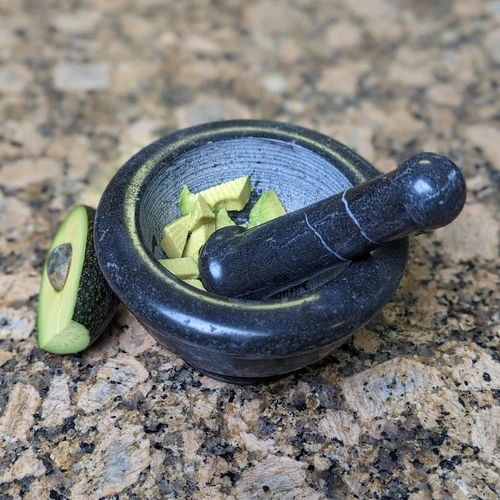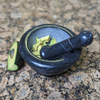Is granite good for pestle and mortar?

A Pestle And Mortar Can Bring Out The Flavour Of Food By Gently Crushing It.
It Slowly Extracts Essential Oils From A Variety Of Ingredients By Breaking Down Rigid Cells More Effectively Than Any Other Method.
Brighter Flavours In Your Curry Pastes, Creamier Pesto And Guacamoles, Zestier Chimichurri, And Other Sauces, And So Much More. Since The Primary Use Of Pestle And Mortars Is To Process Key Flavour-building Ingredients Like Garlic, Ginger, And Spices, There’s No Dish This Tool Cannot Improve.
Flavor Is The Main Attraction, Not Convenience.
Which Is A Pestle And Which Is A Mortar?
We're Putting It Out There Here Since This Is A Question That Many Are Too Timid To Ask. The Pestle Is The Club, And The Mortar Is The Basin. To Ensure That The Pestle Is Not Harmed, They Ought To Be Made Of The Same Material.
Best Material For A Pestle & Mortar
Due To The Pestle And Mortar’s Enduring Appeal, Different Versions Of It Exist All Over The World, From Mexican Molcajete, Made Of Very Coarse Volcanic Stone, To The Small Wine Glass–shaped Ebony Mortar And Pestles Found In Mozambique. Every Style Of Mortar And Pestle Matches The Cuisine Of The Place It Comes From – For Example, The Japanese Suribachi Is Made Of Ceramic With Fine Grooves Throughout Its Interior, Perfect For Grinding Small, Oil-rich Sesame Seeds.
Since We At Bigkitchen.com Are Us-based Home Cooks, We Wanted To Provide Our Customers With The Most Versatile Options, Ones Suited To The Widest Swathe Of Cuisines. We Also Looked For Types That Meet Our Core Values Of Function, Quality And Durability. After Testing, We Found The Best, Most Versatile Options Were Made Of Porcelain And Granite With polished interiors, As The Rougher Texture Allows For More Friction.
While Granite And Porcelain Are Superior At Different Jobs, Both Materials Do A Great Job Of Bringing Out The Flavor Of Ingredients And Are Made To Survive A Lifetime Of Use.
Granite Versus Porcelain Mortars And Pestles
Because You Are Utilizing Brute Force In A Pestle And Mortar, Durability And Hardness Are Important Qualities Shared By Both Granite And Porcelain (Or Ceramic). Both Will Perform Flawlessly On Whatever Task You Give Them, Although Granite Is Superior To Porcelain In Some Situations And Vice Versa.
What You Want To Prepare In A Pestle And Mortar And How Much Work You Want To Put Into Cleaning It Are The Two Key Things To Think About.
Granite Mortars And Pestles Have A Coarser Texture And Weigh Significantly More Than Porcelain Ones. As A Result, Components Adhere To The Mortar More Readily And Experience Greater Force And Friction From The Heavy, Coarse Pestle Grinding Against Them. This Works Well With Slippery Components Like Garlic, Onion, And Ginger As Well As Tough Ones Like Entire Spices. A Granite Mortar And Pestle Is The Best Option If You Intend To Use It For Grinding Whole Spices, Creating Curry Pastes, And Combining Dips Like Guacamole Or Muhammara.
Ideal Dimensions For A Pestle And Mortar
For Preparing Large Amounts Of Spices (For A Jar Of Handmade Spice Mix Like Garam Masala Or Steak Dry Rub, For Example), As Well As Sauces And Dips, Large Pestles And Mortars Are Essential. The Typical Quantities Required By Most Recipes Are Simply Too Much For A Little One To Handle. Large Pestle And Mortars Are The Safest Option, Yet A Medium-sized One Could Work Just As Well.
A Small Or Medium Pestle And Mortar, Such As This 3-piece Iron Pestle And Mortar From Zassenhaus, Will Work Much More Quickly And Thoroughly And Is Much Easier To Store If All You Intend To Do With It Is Quickly Grind Spices, Crush A Handful Of Nuts, Or Make A Single-serving Curry Paste.
Top-rated Mortars And Pestles
John Julian's Trademark Pestle And Mortar Is Admired By Cookbook Luminaries Nigel Slater And Nigella Lawson. Julian Sainsbury, The Founder, Worked With Craftsmen In South India To Learn How To Create Granite Pestles And Mortars. He Gave Up On Granite When He Started John Julian, A Wiltshire-based Business That Sold Both Granite And Porcelain Versions In Order To Maintain Manufacture In The United Kingdom. The Design Is What Distinguishes It. With Just A Slight Rocking Action, A Wide, Flat Pestle Efficiently Grinds Ingredients Without Requiring Lifting—which Can Cause Wrist Pain—and The Bowl's High Edges Minimize Mess. Purchase Here; Accessible With A Shallow Mortar Here As Well.
Granite Mortar And Pestle
In Thailand And India, Granite Is The Traditional Material For Larger Pestles And Mortars. Since Curry Pastes And Spice Mixes Are Prepared In Bigger Quantities And Then Kept As Concentrates, The Bigger Size Is Crucial In This Case. Its Sheer Weight Guarantees That It Will Remain Steady On Your Countertop. The Pestle's Tapered Club-like Design, Which Is Wider At The Mixing End, Makes It Ideal For Both Grinding Along The Bowl's Edge And Directly Striking Ingredients. When Not In Use, This Piece Looks Lovely Displayed On Your Countertop Since It Has Smooth, Polished Surfaces On Both The Mortar's Exterior And The Upper Half Of The Pestle. Compared To A Porcelain Finish, The Interior Is Coarser, But Comparatively
Ceramic/porcelain Mortar And Pestle At The Most Affordable Price Point. We Recommend The Large Or Medium Size, As It Is Ideal For Sauces And Liquid Ingredients. Shop Here.
Crushing Stubborn Spices And Slippery Garlic Is An Easy Task For This Extra-coarse Pestle And Mortar. The Small-medium Size Of This Deep Mortar With High Sides Keeps Things Organized, And It May Be Used For A Variety Of Purposes Such As Crushing A Small Amount Of Marinade, Curry Paste, Or Roasted Nuts To Sprinkle Over Salads. It Is Just The Right Amount Of Weight To Remain Steady On The Counter While Still Being Small And Light Enough To Be Carried To The Sink For Cleaning. Purchase Here.





